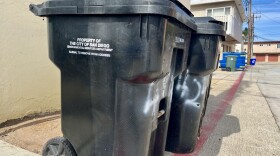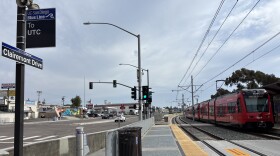Update: The San Diego City Council approved the budget on June 10. Read more.
When we asked San Diegans what they would do to fill the city’s more than $300 million budget shortfall, we received a lot of responses. They were a mixed bag of cost cutting and revenue generating measures. For example, a lot of residents suggested shrinking the police department’s budget or charging increased parking rates at the beach.
The responses showed that city residents in general understood that in order to close the budget gap, cuts would have to be made and revenues increased.
That’s what San Diego Mayor Todd Gloria thinks too. “We are committed to living within our means,” he wrote in his budget proposal released in April.
In order to illustrate what it will take for the city to “live within its means” we’ve created a simple budget challenge. This challenge takes suggestions from the budget proposal and San Diegans, allowing players to pick and choose new expenses, cut costs and raise revenues.
Each line item has a real world value and was fact-checked and verified against the proposed budget and last year’s spending plan. Keep in mind that these items are a snapshot of a very large and complex budget.
Play our Budget Challenge below and see if you can fix the shortfall. When you’re done take a screenshot and share it with friends and family. Don’t forget to tag @kpbs on social media.
Want to know more about the city’s budget and how it’s developed? Here are some frequently asked questions.
“The services that the city provides that folks generally think of when they think of a city service, that's being funded by the general fund,” he said.
Those services include the police and fire departments, city streets, storm drains, parks and libraries.
According to Modica, about 18% of all property taxes paid by residents go to the general fund and about 13% of sales taxes paid in the city ends up in the general fund. Franchise fees and hotel taxes go to special revenue funds, and a portion of those are transferred into the general fund. More specifically 41% percent of revenue generated by the city's Transient Occupancy Tax (TOT) goes to the General Fund, the other 59% are placed in a special revenue fund for the convention center expansion.
Water and sewer are both city services, but they are supported directly by rates that are paid by customers, Modica explained. Residents who have water delivered to their house or are connected to the city's sewer system pay fees that go back to funding those services.
If someone uses more water, Modica said, they're paying more for it; if they use less water, they're paying less for it. They are self-sufficient in that the amount of revenue they need to operate comes from the fees that are being charged. Modica also noted that the city is not allowed to make a profit on enterprise funds. The amount the city charges for water services, cannot be more than the actual cost to provide that service. Payments are also tied to actual water demand and water use.
“When my office looks at the city's budget, we are looking at what our ongoing expenses are. So, those expenditures that we know we'll need to have year over year over year. As well as our ongoing revenues. So, revenues that we know we'll have this year, next year, the year after, the year after,” Modica said. “The structural budget deficit and the structural budget imbalance happens when our ongoing expenses are more or when our ongoing expenses exceed our ongoing revenues.”
According to Modica, a city will often use one-time funding sources to overcome a structural deficit, “and that means that when you get to the next year, even if you balance the current year with additional one-time resources, you're going to be facing additional issues trying to maintain the level of services that you have.”
The city of San Diego’s fiscal year starts on July 1 and ends June 30.
“There's no magic reason why we should start in July and end in June except that it's a common set of dates that a number of surrounding jurisdictions in the area use as well,” Modica said.
In a nondeficit year, Modica said, city leaders ask themselves if the city has the resources available for the expense they are considering. Are there existing revenues that can support it?
In a deficit year, where the city is starting out knowing that it needs to make cuts, decision makers identify what cuts need to be made elsewhere in order to pay for the new expense. And then of those offsetting cuts, what are the impacts?
“We try to lay that all out so that a general sense of those impacts, as well as the specific costs to the city, are known before those decisions are made,” Modica said.
On a day-to-day basis, the work involves looking at the budget and putting it through a review. It also involves meeting with different city departments, Modica said. “Hearing about potential impacts, the pros and cons of the various policies that are being put forward, and really just giving information for the city council to be able to make informed decisions. We don't say what those decisions are. We just want those decisions to be informed by objective information when they're being made,” he said.
“We're independent, which means that we don't report to any single person. We're given a little bit more leeway to be a little bit more objective,” he said. “We don't have a political objective. So we are really guided by just what the facts are. This is what I see. Here are pros and cons to something that's being presented to you, council. You get to make that decision.”
That independence is particularly critical when looking at the organizational structure of the city, Modica added.
“Of the 10,000-plus employees in the city, almost all of them actually report eventually to the mayor. The mayor is an elected political position — quite rightly is an elected political position. As a consequence, he has his own objectives that he would like to proceed with and achieve. The City Council is a separate elected body. It's important that they have, one, the information they need to make decisions, but also that that information isn't colored by a political objective.”





